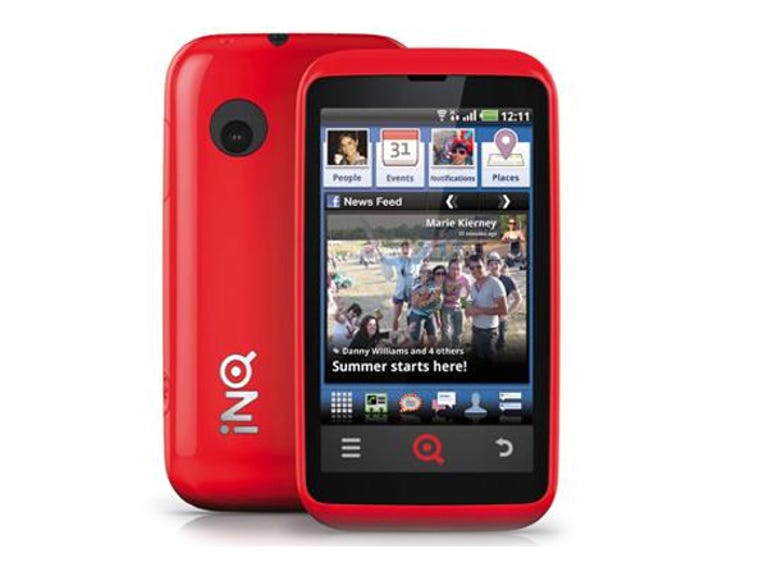 Why You Can Trust CNET
Why You Can Trust CNET INQ Cloud Touch review: INQ Cloud Touch
INQ Cloud Touch is packed with neat enhancements geared towards making smartphone use faster and more relevant to a younger crowd.
At the end of 2008, the Hutchinson-owned handset manufacturer INQ released a cracker of a pre-paid handset, the INQ1, earning itself the honour of being the cheapest 3G handset at the time and taking the top prize at Mobile World Congress 2009 for Best Handset. Since this time, the smartphone market has been turned on its head, and the sub-$300 market that the INQ Cloud Touch plays in is littered with a range of excellent devices from Samsung, LG and Hauwei, to name a few. Can the INQ Cloud Touch earn the same accolades as its forerunner?
The Good
The Bad
The Bottom Line
Design
As part of the Hutchinson family, it's no surprise that the INQ Cloud Touch will be an exclusive member of the VHA range here in Australia. To signify this, the handset will be available in two teeth-achingly bright colours: a brilliant white and a screaming red. The handset chassis looks and feels like an iPhone 3G, only cheaper and more plasticky. Having opened our unit to insert our SIM card beneath the battery cover, we found we couldn't replace the cover properly; though it clicked into place, there was a sizeable gap in the seam running around the edge of the handset.
As with the iPhone 3G, the INQ Cloud Touch relies on a 3.5-inch touchscreen for input, though unlike Apple's stable of products, the Cloud Touch features a comparably low-resolution display. Its 320x480 pixel count is fine for reading text onscreen or sharing photos, but it definitely lacks the impressive punch of clarity and colour that we are coming to expect from phones, even at this price. The graphics on the Cloud Touch look soft, like every image is slightly out-of-focus.
Unfortunately, a higher resolution display wouldn't have helped in making the design of the handsets icons and user interface look any better. We love that INQ has gone to the trouble of skinning so much of the UI with its own images, but there's no helping the fact that the overall aesthetic of this design looks messy and a little childish. Everyone that we showed the phone to had a similar reaction to it, commenting on how they didn't like the look of the phone despite our best attempts to have them look past the design and at some of the unique features.
User experience
There's no doubt in our minds that the team at INQ has given a lot of thought to the design and functionality of the user experience, and what they have delivered includes some really great ideas. Essentially, the Cloud Touch is an Android-powered smartphone (running on Android version 2.2), but the INQ user-overlay is so extensive that Android is barely recognisable under the wealth of custom widgets and icons.
Facebook is the focus on the Cloud Touch, a fact that is unavoidable from the moment you turn the phone on. Central to this experience are five INQ-designed widgets comprised of four shortcuts to specific Facebook features and a large updating news feed. Along the bottom of the screen is a dock, with six visible app shortcuts, that scrolls horizontally to reveal another five smart links. Between these elements, you should feel as connected to Facebook as any person should ever need to be.
Perhaps our favourite customisation is the inclusion of a quick settings shortcut button on the left-side of the handset. Pressing this button reveals a screen overlay allowing the user to quickly connect to a Wi-Fi network, connect to Bluetooth or GPS or set an alarm — plus there's a number of important stats to check, like the remaining battery time.
Multimedia and the Web
There are a few key smartphone elements essential to a good Facebook phone. We know that the INQ has a good notifications system, but what about its connection to the internet and the quality of its camera? INQ doesn't skimp on the connectivity options, with HSDPA and Wi-Fi for jumping online, though the LAN adapter is only compatible with the 802.11 b/g protocols.
The camera is a disappointment, and though the 5-megapixel camera sensor sounds meaty enough, our tests pics all looked pretty shabby. You can see in the test image displayed in this review that the image lacks definition at 100 per cent and that the colours look washed out. We wouldn't be surprised to see users of the Cloud Touch slip their phones back into their pockets and whip out a dedicated camera before taking photos, even for Facebook.

The 100% crop inset shows poor detail, but even compressed, the image isn't great.
(Credit: CBSi)
The Cloud Touch is equipped with standard Android music and video players, meaning that it is capable of playing back a similar range of files that Apple's iPhone can play, but that there is very little user control outside of Play, Skip and Volume Up. INQ does include a dedicated Music Player button on the side of the phone, though, so you can jump into your tunes without any fussing around.
Performance
We were very happy to see the detailed "battery time remaining" section on the Quick Settings menu that we referred to earlier in this review, with its breakdown of standby time, talk time and music playback time left before the battery runs out. However, we can't say we've found this reading to be particularly accurate. We would at times notice that battery life would plateau for long periods before decreasing by large chunks at a time, like 10 hours of standby life in a matter of minutes. All in all, battery life was acceptable, with a-day-and-a-half of light to moderate usage, but gamers killing time on the train should keep a closer eye on their phone's remaining battery life.
Otherwise, the experience of using the Cloud Touch has been pleasant. The touchscreen is responsive and the hardware does a decent job of avoiding lag spikes, though we did stumble across a few software crashes and the occasional extended pause. Call quality was fine during our review, and though the clarity of the ear-piece speaker could be improved, it was certainly loud enough for our purposes.
Overall
The INQ team deserves praise for thinking outside the square and delivering a unique Android experience, though the ingenuity of their concepts are somewhat wasted in the aesthetics of the delivery and in the cheap components chosen in the construction of the Cloud Touch. Facebook fanatics will get good use out of the custom notification widgets, but it'd also be worth checking out other Android devices in this price range, as the standard Facebook experience is very good.


